-
A Synopsis for the History and Operation of the Competition for the Reconstruction of Destroyed Palestinian Villages "Year 2":
To download full Competition brochure for Year 2, click the link below:
Competition_Brochure_2018_Year2
- Notice of the Competition for the Reconstruction of Destroyed Palestinian Villages "Year 2" :
-
Jury deliberating the submissions of the Competition for the Reconstruction of Destroyed Palestinian Villages "Year 2" :
-
Announcement of awards of the Competition for the Reconstruction of Destroyed Palestinian Villages "Year 2" :
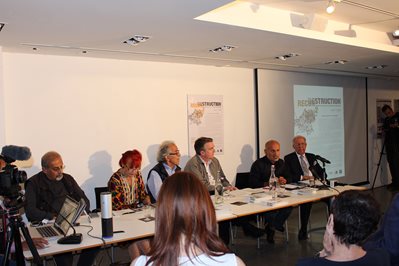
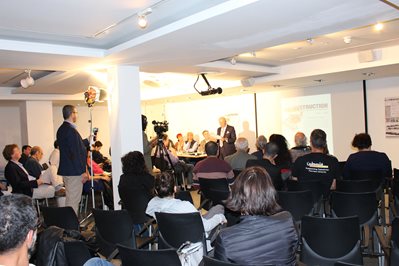
-
The winners of the Competition for the Reconstruction of Destroyed Palestinian Villages "Year 2" are:
The first prize:
Yazan Nasrallah,
University of Petra , Amman, Jordan, (UOP01)
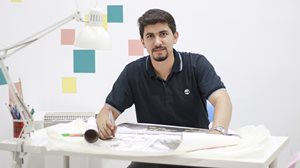 Project: Al Qastal- Jerusalem district.
Project: Al Qastal- Jerusalem district.
Reconstruction of AL-Qastal Village
The project is aim to reconstruction of one of Palestine villages that were destroyed by the occupation forces in 1948 and design spaces that can help the refugees to overcome the psychological impact of the occupation.
the occupation ethnic cleansing of Palestine in 1948 depopulated 675 towns and villages, mostly destroyed.
The chosen village is ALQastal village in Jerusalem.
The first Arab village occupied in 1948, after a violent battle led by Abdul Qader Husseini, who was martyred in this battle, the battle took place because of its strategic location, West Jerusalem.
The village is located on the top of Al-Qastal hill, which was inhabited by 104 people before 1948. Now, the number of refugees from the village is estimated at 1500, and all the houses of the village were demolished during the Nakba.
There is a castle on the top of the hill, a small Roman castle that still exists, and there are also trenches around the castle that were used for military purposes.
The village of Qastal located in an important location for Jerusalem, overlooking the Jerusalem-Jaffa road.
On the land of Qastal in 1948, the battle of Qastal took a place. and Abd al-Qadir al-Husseini have been martyred in this battle - one of the most important leaders of Palestine -.
The residents were able to liberate their village from the occupation forces in that battle, but after the martyrdom of the commander, everyone went to his funeral and left the village, so the occupation was able to control it.
In this project we review the narrative and story of Qastal and the historical events that took place through a unique architectural experience.
It is important to know that the village was completely cleared and left only an old Roman castle and a trench surrounded by it.
**********************************************************************************************************************************************************
The second prize:
Arwa Qalalwa, Birzeit University, Palestine. (BZU03)
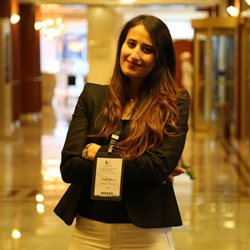 Project: Qula – Al Ramle district.
Project: Qula – Al Ramle district.
Our stories, symbols, images, music, and traditions all formulate part of our collective memory,
What we remember and how we remember it, helps us formulate our identities; subsequently, our memories help us sustain our history, tradition, and culture in the face of obliviousness.
In the tragic Nakba events, the Village of Qula fell under Israeli control as well as with many other villages in Palestine. Nothing was left, Qula's inhabitants were completely ethnically cleansed and those who stayed alive were depopulated.
By the 14
th of July in1948, Qula was completely obliterated and only house rubble left behind.
Upon experiencing uprooting, Palestinians were dispersed and broken; moreover , the Palestinian identity have become more and more threatened due to the continuous attempts of Israeli policies to erase all Palestinian traces and thus, destroy their collective memory. This is exactly what happened in the case of Qula village, after the ethnic cleansing of its people, two main highways were constructed 50 years earlier from now; penetrating the village, in addition to a man-made forest (Kula Forest) that covers a large portion of the village site, wiping it off the map.
For so long, Palestinians have been threatened in their identity, culture, tradition and collective memory. It is crucial to do something in an attempt to restore our homeland; this is the main reason for me participating in this competition, as I saw this as an opportunity for a historical documentation that aims to revitalize Palestinian memory and stress their right of return.
As the younger generations are becoming increasingly detached from their heritage, this even made me realize the persistent need to address Palestine's memory differently. I saw an important role of architecture in reviving the identity of Palestinian villages.
The initial idea started out with the intention of preserving Palestinian tradition and natural features. Listening to stories of people from Qula Village and translating their memories into architecture. The main force for my concept was to restore Palestinian memories by using elements of the traditional Palestinian architecture, in which the old will mix with the new to sustain the Palestinian heritage. Therefore, the overall design is a reflection of the Palestinian collective memory.
Layers of history have accumulated upon one another in Palestine and in this village specifically, keeping them is essential for the writing of history, since there are also many impressive ruins from the Crusader and Ottoman periods.
By keeping the ruins and material remains, I made them a base for restoring the old Qula village. As a start, the main highway penetrating the village was kept, but the part inside the village was made underground, to reconnect the old village site and stitch it together.
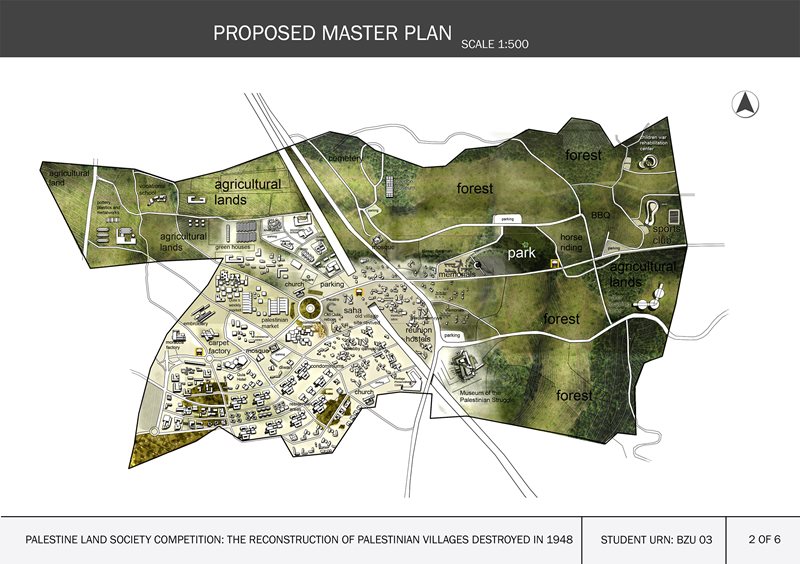
In the old village site as well, there is a "Saha" for all the villagers' gatherings and evenings, as well as an interconnected amphitheater for all their musical events, dabka's and parties. The reunion hostels are also included in the old Qula site near the original ruined houses and approaching the forest; that constitute material cultural heritage.
In 1948, Qula's inhabitants were almost 1172, and by using the equation of 2.75% increase rate of population, in 2018 they would be almost 7828 people, The master plan is prepared to accommodate almost to 8500 people, with the possibility of future extension, in which the master plan increases the connectivity within its own contextual fabric and to the rest of Palestine.
As for the residential area, which extends from the old Qula village, it includes detached houses, villas, apartments, and condominiums, with two green parks serving the area and one additional large park near the Forest.
Serving this area, a hospital, a library, a kindergarten, an elementary and secondary school, there is also a cultural center, and Palestine's youth center. There is also a cemetery which is an extension of the old Qula cemetery. As for their religious needs; two mosques and two churches are distributed along Qula's land area.
A Palestinian market forms a hub for all village inhabitants, in addition to Qula's weekly market that changes its activities every week to form a strong interactive zone.
Near that are many shops and commercial zones with an exquisite taste of Palestinian life. It forms a cluster-like form that seems to vanish into the landscape, stressing the further dimension of the wealth of the Palestinian cultural diversity.
A series of workshops for embroidery, cloth making, artifacts, and Pottery are near this social hub, there is also a carpet factory that is connected to the weekly market.
To the south of the village, there are all the agricultural fields (cereal, olives…), as well as greenhouses and agricultural buildings; which form a temporary structure (light structure) that can be removed to different places. In addition to a vocational school that is inside the agricultural zone, where crafts, carpentry, and dairy production and products are learned.
The factories (Plastics, carpentry and metal works) are to the west of the agricultural lands and far from the residential area. By investing in both agriculture and industry, this will increase the development of the national economy and increase employment opportunities and by self-producing and the investment in cultural heritage; the village can economically boom and maintain its presence.
More focus was made on the spatial and cultural landscape, which forms a crucial part of Palestine's Identity. The forest was maintained with some development on the landscape in some of its areas. Moreover, by Protecting and developing natural and cultural resources, along with expanding and diversifying areas that attract tourism, It would flourish the tourism sector, with the many touristic attractions such as the Museum of the Palestinian struggle, in addition to memorials that prevent the process of forgetting, and create an experience that stimulates flashbacks and strengthens the language of remembering,
Memorials are to the east of the village, near the forest, they include memorials of war and memorials of heroes defending the country like the famous Palestinian leader Hasan Salameh, who commanded the defenses of al-Lydd and al-Ramla cities during the 1948 war. Archeological sites were also preserved and are a part of the touristic attractions.
The design includes not only living spaces but also a series of social and cooperative environments that lead to many outdoor and social areas, creating a stimulating experience for the villagers and their visitors. They also include meeting clubs, public squares, old café zones, horse riding activities and many interactive workshops that embrace the events of the villagers.
There are also many associations such as "Children's War Rehabilitation Center", a sports club, and a large park that includes areas for BBQ as well as equestrian activities.
Urban fabric in this village is formed mainly from traditional architecture with some modern additions; traditional architecture forms the hub (the center) of the village, and all developments are made around this hub.
Each memory tells a part of the Palestinian Question, due to its connection to collective and individual memory. I allowed memories themselves to compose the spatial relationships in the design; by listening and reading to stories of people from Qula, it was important to reconstruct the village to resemble their memories, so that the new generation will still continue to connect to their roots, and acknowledge their family background and will never forget where they came from. Each corner of the village aims to create a story; people's connectivity and interaction are a basis to this village.
By bringing out the Palestinian memories in designs that resemble their culture, the overall image of the village is intimately connected to the context of any Palestinian village and to the rest of Palestine.
Finally, despite the fact that Palestinians were victims to internal divisions and many fragmentations, they never abandoned their own traditional rituals. I am in the hope that one day; Palestinians will have the right of return and truly reconstruct their homeland.
**********************************************************************************************************************************************************
The third prize:
Loay Deek, Birzeit University, Palestine, (BZU02)
Project: Beit Jibrin- Al Khalil (Hebron) district.
1. PALESTNE: ONE STATE
After several readings and research about the Palestinian case and the different proposals for solving such issue, (Vox, 2018) I saw that the most reasonable solution is the creation of one single state among the Palestinians and Israelis, which is to be reached peacefully. However, Palestinians would have the authority over the land. Giving the ‘Jews; the possibility to live in Palestine too.
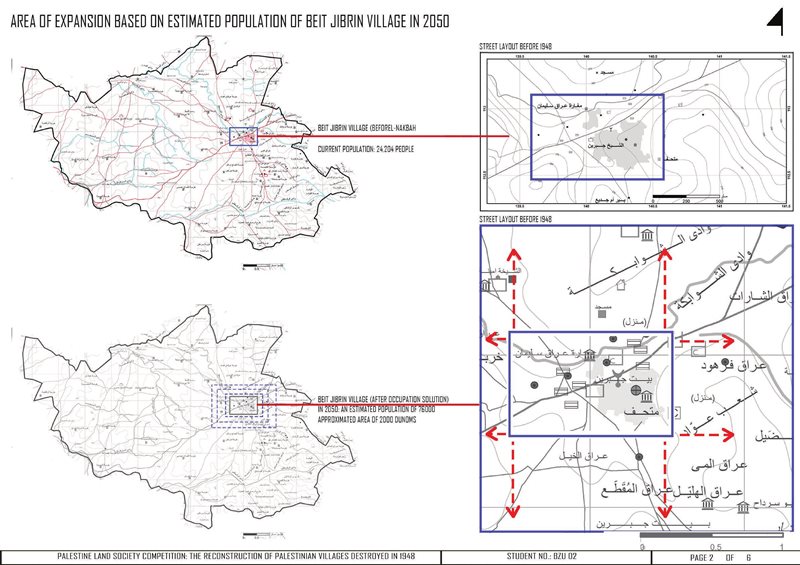
2. THE DETROYED VILLAGES: LINKING ENTITIES
Reaching a proposal for the destroyed villages couldn’t be done without knowing the undergoing Israeli fragmenting strategy of the West Bank. One of the most critical strategies of the ‘Israelis’ is applying the Jewish settlements, aiming to fragment the west bank into different states, further causing each state to be ruled by its own, and thus leaving the current West Bank in a ragmented manner. This is issue is already increasing throughout the West Bank. Therefore, on the scale of the urban planning, it would be necessary to discuss the issue of fragmentation of the West Bank that has occurred during the Israeli occupation, and which will have its effect ongoing after the occupation. In terms of planning, I aim to relink the already fragmented enclaves of the West bank (e.g. Toulkarem, Nablus, Ramallah……. etc) among each other and with the ‘previously’ occupied part (Israel). (AlJazeera, 2018) Therefore, one solution is to confront such fragmentation through using the destroyed villages of Palestine. Rather than reclaiming them as being under the rule of their districts/enclaves (e.g. beit Jibrin related to the sub-district of Hebron), I aim to consider them as independent entities, as having
them under the rule of their past districts/enclaves will do nothing but enlarge the enclaves that are currently occurring.
When I note independent entities, I do not mean fragmented entitied, but, more of linking entities, that link each enclave from the ‘previous West Bank’ to a different city from the ‘previously occupied part of Palestine’. These independent entities will perform their linking
role in terms of infrastructure and activities. The village I chose, which is Beit Jibrin, has the ultimate potential to link Hebron with Askalan, as it is a pass-through entity between the East and West, and towards the North. Therefore, the village would act as a main transit stop in
Palestine. Moreover, as Hebron is a productive city that depends primarily on trade for its economic growth, as well as Askalan (as it falls on the west coast of Palestine), Beit Jibrin would be a major place to market the products of both cities, through the different expositions and daily markets and warehouses in the village.
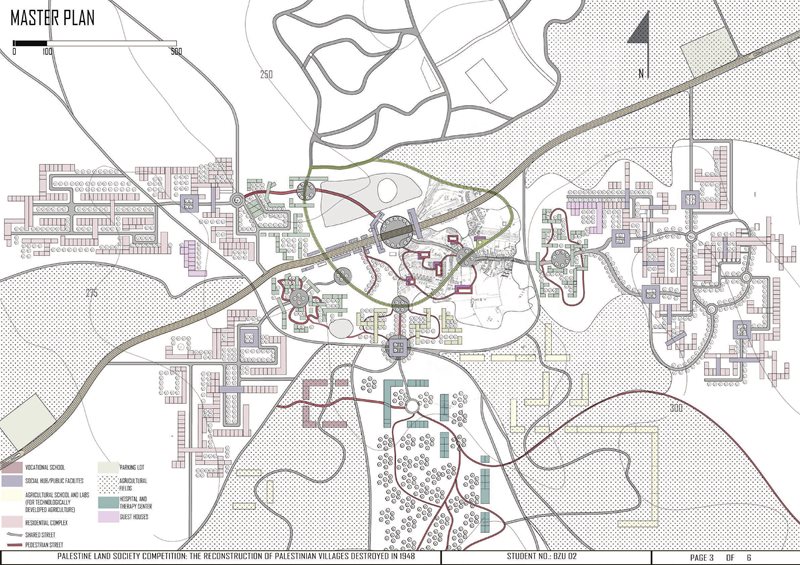
In addition, and referring the term ‘linking entity’ to different matters, such expression is also applicable to sustainability, as the village would be able to trade the part of the solid waste as well as some organic waste from both Hebron and Askalan in order to partially
produce energy for the three states: Askalan, Hebron and Beit Jibrin. Energy production will be through a power plant in the village (taking into consideration the positive effect of having a green power plant in the urban context in terms of energy saving and hosting several activities) and the reuse of part of the solid waste (from wood and glass leftovers as an example) it would
be the generator of different workshops within the village, therefore, rather than importing or demolishing trees for craftsmanship, some leftovers from both states can be reused in Beit Jibrin. Therefore, such logistic relation among the three states is what could bond them
together rather than leave each city/district to act on its own.

3. AGRICULTURAL DEVELOPMENT
Moreover, having the fact that all Palestinian villages where mainly depending on agriculture, I would consider it also as a main source for living, as most people have abandoned their lands as a main source of income (where the occupation has played an important role), I
aim to reintegrate the agriculture within the daily life of its people through integrating it within the village itself. More importantly, technologically developed agriculture techniques are to be integrated within the vocational education in the city itself, where the vocational and the elementary school is to be located within the agricultural fields themselves to integrate students with the land itself.
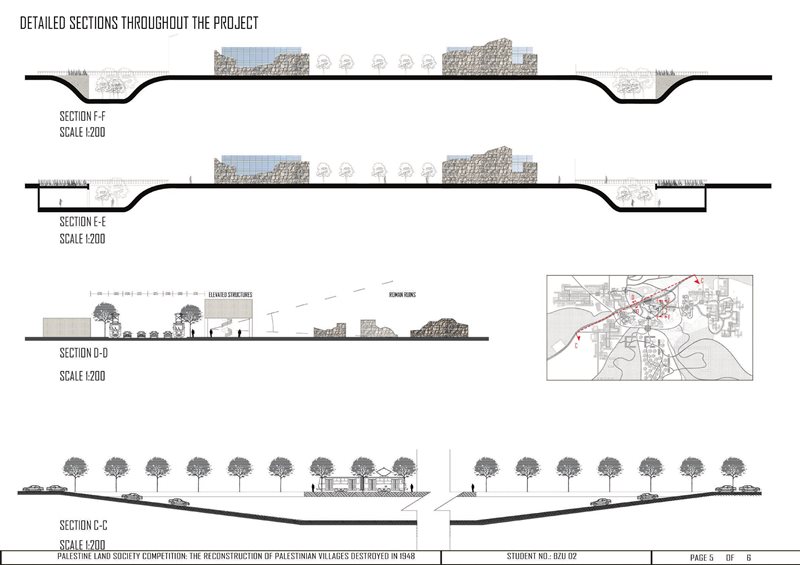
4. TOURISTIC DEVELOPMENT
However, the potentials of the village do not stop here; as tourism is to be considered a main source of economic growth, as explained in the following part: - Beit Jibrin is a multilayered village, where different eras have been there, from roman to Jewish to Arab to Israeli, and where each époque has left its trace. Such multi layering has given it a credit it to be a major touristic village. Therefore, in addition to trade and production, tourism would be a major source for economic growth.
Tourism is to be focused on by emphasizing such multi layering the city has, where the roman part is to be left as is in addition to roposing an enclosed pedestrian pathway throughout its ruins to keep the visitors in close connections to such layer. Moreover, regarding he past village of Beit Jibrin itself, it has been mostly destroyed, leaving some ruins of very few buildings. Moreover, the old composition of he village Is to be traced on its original location, having no additional structure to be built on the same level of the destroyed part of the illage, rather, the built up area at that location is to be underground, leaving the terrain level for the sketched trace of the village and some reused ruins. Such approach was chosen in order to emphasize the existence of the main village of Beit Jibrin, and its original configuration. Moreover, part of the Kibbutz of Beit Guvrin (falling on the land of Beit Jibrin) is to be used as a touristic area that shows the era where Palestine was under occupation, while most of the Kibbutz is to remain for the Jews if they prefer to stay.
*Note: the proposed tracing of the village as shown in the master plan is a supposed representation, as I wasn’t able to find the original masterplan of Beit Jibrin along with the exact locations of the built up areas).
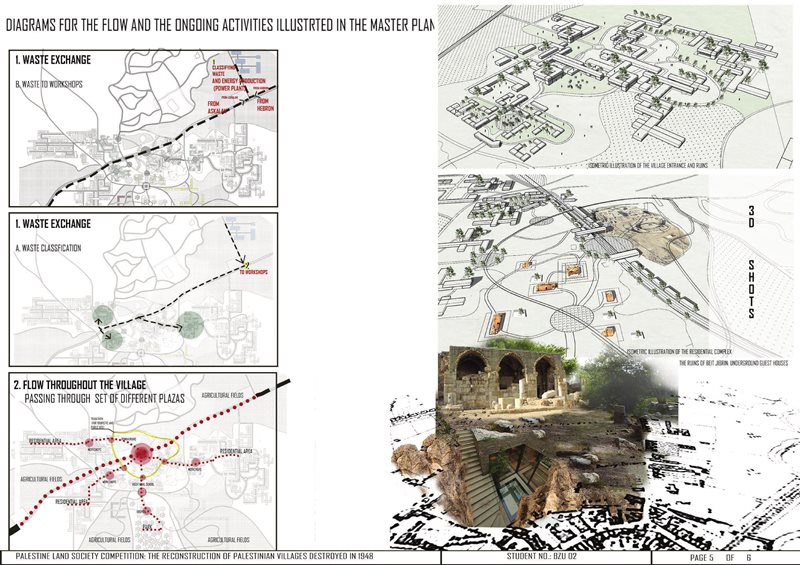
Based on such thought, the configuration of the village was thought of first by reclaiming the civic/public space in the midst of the ruins of the village, where the highway (35) that links between the East and West of Palestine is to be transformed as an underground tunnel, leaving the terrain as a shared street for slow pace car flow, tram flow and pedestrian flow, such street meets in the middle an urban plaza where the different ruins revolve around, in addition to the different workshops mentioned before, as well as parts of the agricultural fields that are exposed to the public. The different pedestrian and shared streets are distributed from the public plaza, each to a specific station, form the Beit Jibrin ruins memorial to the Kibbutz of Beit Guvrin exposition to the roman ruins. The other stations are the workshops themselves each configured in a cluster composition, where each part opens to a small plaza for product exposition. Such stations are not sites for touristic visits only, rather, they are also the main pedestrian passages to the dwellings of the residents of Beit Jibrin, where they are configuredin a clustered composition too, as each group of houses are clustered together around courtyards in addition to the private backyards of each house. This plaza hosts the transit station for the tram.